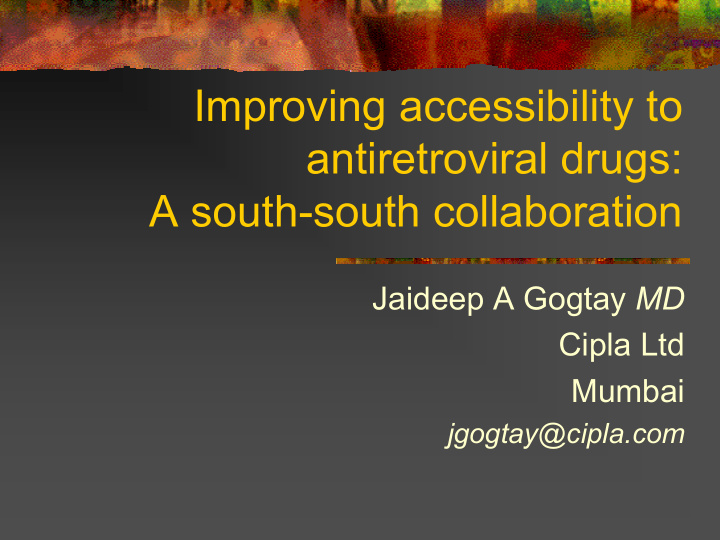



Improving accessibility to antiretroviral drugs: A south-south collaboration Jaideep A Gogtay MD Cipla Ltd Mumbai jgogtay@cipla.com
Adults and children estimated to be living with HIV at the end of 2000 Western Europe 540 000 North America Eastern Europe & East Asia & 920 000 Central Asia Pacific 700 000 640 000 Caribbean North Africa 390 000 and Middle East South & 400 000 South-East Asia Latin America 5.8 million 1.4 million Australia & New Zealand Sub-Saharan 15 000 Africa 25.3 million Total : 36.1 million Source: World Health Organization
HIV Infections worldwide - 2000 � More than 15000 new HIV infections every day. � >95% are in developing countries � 1600 infections among children <15 yrs age � About 14000 infections are between 15-49 yrs age group, of whom; � >40% are women � >50% are 15-24 yrs old
HIV/AIDS : Global Overview UNAIDS June 2000 Country HIV Adult AIDS AIDS Estimate Rate (%) Deaths Orphanss Botswana 290,000 35.8 24,000 66,000 Swaziland 130,000 25.3 7,100 12,000 Zimbabwe 15,00,000 25.1 1,60,000 9,00,000 Zambia 8,70,000 20.0 99,000 6,50,000 S Africa 42,00,000 19.9 2,50,000 4,20,000 Namibia 1,60,000 19.5 18,000 67,000 Thailand 7,55,000 2.2 66,000 75,000 India 37,00,000 0.7 3,10,000 ?
Waves in HIV Epidemic & its Impact Wave III Wave IV Wave II Wave I Spouses & Sex Adolescents Male STD Pts, Children of Workers/ Mobile Groups. Male STD Pts IDUs Survivors Trauma, Illness Long-term Socio- Spread of HIV AIDS Pts, ANCs, & Death economic impact Pediatric AIDS STD Patients STD & TB Patients Orphans
Impact of HIV/AIDS � Mainly affects the economically productive age group � In Africa has had an effect on productivity and slowing of economies � Reduction in average life expectancy � Shortage of both unskilled and skilled workers e.g. teachers � Long term medical, economic and social consequences
Management of HIV/AIDS � Diagnosis based on clinical suspicion and laboratory evaluation � Treatment and prevention of opportunistic infections � Regular monitoring � Antiretroviral therapy � Patient counseling
GOAL OF ANTIRETROVIRAL THERAPY Viral Load 0 2 4 6 8 10 Time (years)
Efficacy of ARV therapy Mother to Post Clinical child exposure Management transmission prophylaxis
Currently available drugs NRTIs PIs Azidothymidine Saquinavir-SGC ddI Ritonavir ddC Indinavir Stavudine Nelfinavir Lamivudine Amprenavir Abacavir Lopinavir/ritonavir Various combinations NNRTIs Delavirdine Nevirapine Efavirenz
When to start therapy? DHHS IAS BHIVA Symp + + + CD4 <350 <350 <350 PVL >55,000 >30,000 >55,000
Where are we with HIV therapy today � 20 th year into the epidemic � 6 th year of HAART � 15 drugs � Survival time has increased four-fold after diagnosis of AIDS, from 11 months to 46 months
Trends in Age-Adjusted* Rates of Death due to HIV Infection, USA, 1982-1998 18 Deaths per 100,000 Population 16 14 12 10 8 6 4 2 0 82 84 86 88 90 92 94 96 98** Year *Using the age distribution of the projected **Preliminary 1998 data year 2000 US population as the standard.
Cost of ART � USA, Europe – 10,000-12,000 $ per year per patient � India- less than 10% � Can further come down by 30-40% � Can be repeated in other developing countries
ART is cost-effective � ART reduces hospitalizations and the need to visit the hospital frequently � Thus ART may actually save money in the long run � Demonstrated in developed and developing countries like Brazil
ART usage � Benefit more than thrombolytic therapy in patients with AMI/heart attacks � More cost effective than non-HIV diseases Radiation therapy for early breast cancer � Treatment of hypercholesterolemia for heart � disease Dialysis �
Cipla � Manufactures 6 antiretroviral drugs and those for treating opportunistic infections � Plants are approved by many international regulatory agencies like FDA, MCA, TGA, MCC, etc � Is poised to supply to some African countries like Nigeria, Cameroon, Ivory Coast, Ethiopia etc � With the help of MSF to Cambodia and Guatemala
MTCT project � Cipla is currently working with NACO and UNICEF to make available nevirapine for prevention of mother to child transmission of HIV at no cost � 2 year project
Need of the hour � Collaboration between developing countries for diseases like AIDS which threaten development � Generic companies can play a vital role � Fast track registration of antiretroviral drugs with possible harmonization of regulatory requirements � Development of adequate infrastructure and physician training � Encouragement and support government, NGOs and other organizations
Challenges in HIV/AIDS � Prevent new infections � Those already infected, and can take treatment avert illness and death by maximizing the effectiveness of treatments � Increase access to greater number of patients who need the treatment
AIDS is no longer merely a health issue, but a developmental issue
Recommend
More recommend